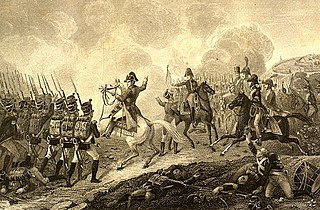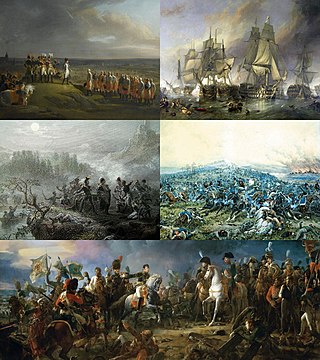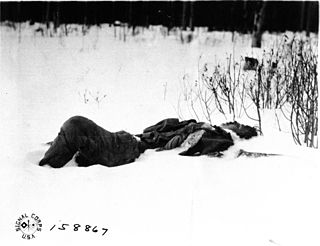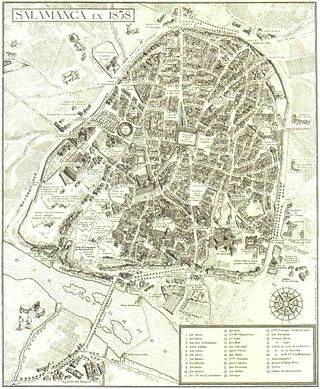
In the Battle of Lützen, Napoleon I of France defeated an allied army of the Sixth Coalition.

The Battle of Leipzig, also known as the Battle of the Nations, was fought from 16 to 19 October 1813 at Leipzig, Saxony. The Coalition armies of Austria, Prussia, Sweden, and Russia, led by Tsar Alexander I and Karl von Schwarzenberg, decisively defeated the Grande Armée of French Emperor Napoleon Bonaparte. Napoleon's army also contained Polish and Italian troops, as well as Germans from the Confederation of the Rhine. The battle was the culmination of the German Campaign of 1813 and involved 560,000 soldiers, 2,200 artillery pieces, the expenditure of 400,000 rounds of artillery ammunition, and 133,000 casualties, making it the largest battle of the Napoleonic Wars, and the largest battle in Europe prior to World War I.

The Battle of the Alma took place during the Crimean War between an allied expeditionary force and Russian forces defending the Crimean Peninsula on 20 September 1854. The allies had made a surprise landing in Crimea on 14 September. The allied commanders, Maréchal Jacques Leroy de Saint-Arnaud and Lord Raglan, then marched toward the strategically important port city of Sevastopol, 45 km (28 mi) away. Russian commander Prince Alexander Sergeyevich Menshikov rushed his available forces to the last natural defensive position before the city, the Alma Heights, south of the Alma River.

The Battle of Craonne was a battle between an Imperial French army under Emperor Napoleon I opposing a combined army of Imperial Russians and Prussians led by Prussian Field Marshal Gebhard Leberecht von Blücher. The War of the Sixth Coalition engagement began when the bulk of Napoleon's army tried to drive Mikhail Semyonovich Vorontsov's 22,000 Russians off the Chemin des Dames plateau to the west of Craonne. After a bitter struggle, Napoleon's attacks compelled Vorontsov's force to withdraw, but French casualties exceeded Russian losses. While the battle raged, Blücher's attempt to turn Napoleon's east flank ended in failure due to poor planning.

The Battle of Inkerman was fought during the Crimean War on 5 November 1854 between the allied armies of Britain and France against the Imperial Russian Army. The battle broke the will of the Russian Army to defeat the allies in the field, and was followed by the Siege of Sevastopol. The role of troops fighting mostly on their own initiative due to the foggy conditions during the battle has earned the engagement the name "The Soldier's Battle."

The War of the Third Coalition was a European conflict lasting from 1805 to 1806. During the war, France and its client states under Napoleon I opposed an alliance, the Third Coalition, which was made up of the United Kingdom, the Austrian Empire, the Russian Empire, Naples, Sicily, and Sweden. Prussia remained neutral during the war.

The Battle of Rossbach took place on 5 November 1757 during the Third Silesian War near the village of Rossbach (Roßbach), in the Electorate of Saxony. It is sometimes called the Battle of, or at, Reichardtswerben, after a different nearby town. In this 90-minute battle, Frederick the Great, king of Prussia, defeated an Allied army composed of French forces augmented by a contingent of the Reichsarmee of the Holy Roman Empire. The French and Imperial army included 41,110 men, opposing a considerably smaller Prussian force of 22,000. Despite overwhelming odds, Frederick managed to defeat the Imperials and the French.

The Battle of Glendale, also known as the Battle of Frayser's Farm, Frazier's Farm, Nelson's Farm, Charles City Crossroads, New Market Road, or Riddell's Shop, took place on June 30, 1862, in Henrico County, Virginia, on the sixth day of the Seven Days Battles of the American Civil War.

The Allied intervention in the Russian Civil War consisted of a series of multi-national military expeditions that began in 1918. The initial impetus behind the interventions was to secure munitions and supply depots from falling into the German Empire's hands, particularly after the Bolsheviks signed the Treaty of Brest-Litovsk, and to rescue the Allied forces that had become trapped within Russia after the 1917 October Revolution. After the Armistice of 11 November 1918, the Allied plan changed to helping the White forces in the Russian Civil War. After the Whites collapsed, the Allies withdrew their forces from Russia by 1925.

The North Russia intervention, also known as the Northern Russian expedition, the Archangel campaign, and the Murman deployment, was part of the Allied intervention in the Russian Civil War after the October Revolution. The intervention brought about the involvement of foreign troops in the Russian Civil War on the side of the White movement. The movement was ultimately defeated, while the British-led Allied forces withdrew from Northern Russia after fighting a number of defensive actions against the Bolsheviks, such as the Battle of Bolshie Ozerki. The campaign lasted from March 1918, during the final months of World War I, to October 1919.

The Battle of Fère-Champenoise was fought between two Imperial French corps led by Marshals Auguste de Marmont and Édouard Mortier, duc de Trévise and a larger Coalition force composed of cavalry from the Austrian Empire, Kingdom of Prussia, Kingdom of Württemberg, and Russian Empire. Caught by surprise by Field Marshal Karl Philipp, Prince of Schwarzenberg's main Coalition army, the forces under Marmont and Mortier were steadily driven back and finally completely routed by aggressive Allied horsemen and gunners, suffering heavy casualties and the loss of most of their artillery. Two divisions of French National Guards under Michel-Marie Pacthod escorting a nearby convoy were also attacked and wiped out in the Battle of Bannes. The battleground was near the town Fère-Champenoise located 40 kilometres (25 mi) southwest of Châlons-en-Champagne.
The Battle of Tulgas was part of the North Russia Intervention into the Russian Civil War and was fought between Allied and Bolshevik troops on the Northern Dvina River 200 miles south of Arkhangelsk. It took place on the day the armistice ending World War I was signed, November 11, 1918, and is sometimes referred to as "The Battle of Armistice Day." Shortly before the battle, the freezing of the local waterways resulted in the cutting off of the Tulgas Garrison from outside assistance, and the freezing of the ground let the Bolsheviks move troops to surround Tulgas. The Bolsheviks used this opportunity and their superior numbers to try to attack and conquer the isolated outpost, but were driven back with severe losses.

The Battle of Tientsin, or the Relief of Tientsin, occurred on 13–14 July 1900, during the Boxer Rebellion in Northern China. A multinational military force, representing the Eight-Nation Alliance, rescued a besieged population of foreign nationals in the city of Tianjin by defeating the Chinese Imperial army and Boxers. The capture of Tianjin gave the Eight-Nation Alliance a base to launch a rescue mission for the foreign nationals besieged in the Legation Quarter of Beijing and to capture Beijing.

The Russian Civil War (1917–1921) began after the provisional government collapsed and the Bolshevik party assumed power in October 1917. The principal fighting occurred between the Bolshevik Red Army and the forces of the White Army, a group of loosely allied anti-Bolshevik forces. During the war several foreign armies took part, mostly fighting against the Red Army—including the Western allies—and many foreign volunteers fought for both sides. Other nationalist and regional political groups also participated in the war, including the Ukrainian nationalist Green Army, the Ukrainian anarchist Insurgent Army and Black Guards, and warlords such as Ungern von Sternberg. Despite some pressure from Britain, the Australian Prime Minister, William Hughes, had refused to commit forces to Russia following the end of World War I in 1918.
The Battle of the Crna Bend was a significant military engagement fought between the forces of the Central Powers and the Entente in May 1917. It was part of the Allied Spring Offensive of the same year that was designed to break the stalemate on the Macedonian Front. Despite the considerable numerical and material advantage of the attackers over the defenders, the Bulgarian and German defence of the positions in the loop of the river Crna remained a formidable obstacle, which the Allies were unable to defeat not only in 1917 but until the end of the war.

The Battle of Romanovka was fought in June 1919 during the Russian Civil War. Russian Bolsheviks of Yakov Tryapitsyn launched a surprise attack on an American army camp at Romanovka, near Vladivostok. As a result of the engagement, the attacks were repelled. Romanovka and the Suchan Valley Campaign that followed were the final major engagements of the Russian Civil War involving the United States. Battles would later break out again between the Americans and Soviets, as well as the Cossacks, on much smaller scales. Likewise, the Americans were invariably victorious.

The second siege of Badajoz saw an Anglo-Portuguese Army, first led by William Carr Beresford and later commanded by Arthur Wellesley, the Viscount Wellington, besiege a French garrison under Armand Philippon at Badajoz, Spain. After failing to force a surrender, Wellington withdrew his army when the French mounted a successful relief effort by combining the armies of Marshals Nicolas Soult and Auguste Marmont. The action was fought during the Peninsular War, part of the Napoleonic Wars. Badajoz is located 6 kilometres (4 mi) from the Portuguese border on the Guadiana River in western Spain.

The Battle of Bolshie Ozerki was a major engagement fought during the Allied North Russia Intervention in the Russian Civil War. Beginning on March 31, 1919, a force of British, American, Polish, and White Russian troops engaged several Red Army partisan regiments at the village of Bolshie Ozerki. Although the initial Allied attacks were repelled, the outnumbered Allies managed to repel the Soviet flanking attempts that followed and the Red Army was later ordered to withdraw. Allied forces began to withdraw rapidly from northern Russia shortly thereafter.
The Battle of Vystavka was the defense of the village of Vystavka and several neighboring villages by Allied forces against a series of attacks from the Red Army during the Allied intervention in the Russian Civil War in late January-early March, 1919.

The siege of the Salamanca forts saw an 800-man Imperial French garrison directed by Lieutenant Colonel Duchemin defend three fortified convents in the city of Salamanca against the 48,000-strong Allied army led by Arthur Wellesley, Lord Wellington. During this time, the French commander Marshal Auguste de Marmont led a 40,000-man French army in an unsuccessful attempt to relieve the garrison. An Allied failure to bring sufficient artillery ammunition caused the siege to be prolonged. The garrison repulsed a premature British attempt to storm the fortified convents on 23 June, but finally surrendered four days later after an artillery bombardment breached one fort and set another one on fire. During his maneuvering, Marmont formed the idea that Wellington was only willing to act on the defensive. This mistaken notion would contribute to Marmont's defeat at the Battle of Salamanca a month later.


















